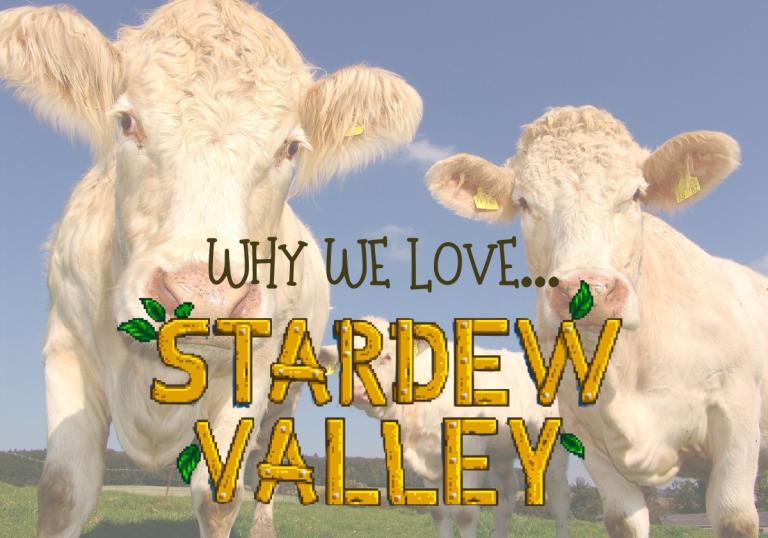
For those not familiar with the title, Stardew Valley is a cozy farm simulator that has been played and enjoyed by millions of adoring fans across multiple gaming systems since 2016. Not unlike Harvest Moon which came decades prior, Stardew Valley puts the character in charge of a farm that has seen better days, but one still brimming with potential. Over time, the player can decide how they will imagine their new home and how much (or little) to interact with the townspeople who live close by.
Recently, we have seen the release of countless other games which fall into this same genre; but none have quite had the same impact as Stardew Valley. One reason for this is the game’s unique setup. Yes, there are cute, not-so-unique elements littered throughout The Valley–ducks, pigs, sheep, cows, chickens, rabbits, songbirds, and even friendly bears in the woods–but what sets this game apart is the true to life somberness woven throughout all involved in the story.
To start, the player begins where all adventures find their genesis (at least according to Joseph Campbell): the call to adventure. Having been burned out by the daily nine to five grind, the player leaves their cubicle after being gifted a rural farm by their now deceased grandfather. Expecting nothing more than to escape the harsh reality of city life, the player is eager to tuck away into a cozy corner of the world and putter around in the garden (kind of a boring adventure, if you ask me!). However, they quickly find that that is not going to be the case. The farm is a mess. Weeds abound. Fallen branches and breakable stones litter the landscape, while some materials are simply too difficult to break with your current array of less than ideal hand tools.
As time goes by, you eventually gain the instruments and skills to take care of these roadblocks, typical of all RPGs and life simulators. There is a leveling up system, as well as ways to improve your tools, machines, and other necessary implements. But for as many similarities as this game has to other titles like it, there are a number of unique features that, I’ll argue, assist players in becoming better versions of themselves.
It is for these reasons we love Stardew Valley so damn much.
SLOW DOWN, FOR TOMORROW SHALL COME
In Stardew Valley, there is never enough time to finish every task. Days are too short and there is too much work to be done. And while some players enjoy achieving all the rewards YouTube bestows on those who can make the most profit, or unlock everything in the quickest time, or enchant every tool to its fullest ability, others (like myself) quickly realize that the point of the game isn’t to “win” in this way. The point is to enjoy the process of the game itself.
And look, I am not going to judge anyone who craves unlocking these achievements–part of the addiction of games like Stardew Valley comes from the dopamine hit we get as we level up and complete minor tasks on our way to a major goal–it just seems that that is to miss the main point of the game. Slow down. Be present. Actually take time to walk around your farm. Allow some sections to be overgrown so that you can enjoy the process of taming things back down. Cycles are good, so don’t get bogged down by the sterility of a perfectly planned and executed project.
CHANGE IS GOOD
In Stardew Valley, as it is with real life, change comes (sometimes abruptly). This is a good thing. I remember the first time I played through a full winter (each season is on a twenty-eight day cycle). I’ll admit that even I was getting bored. I couldn’t wait for the thaw! Then it happened. The first day of spring, and just like that, the trees were in full bloom, grasses had come up, and the farm was ready for its first full productive season (year one tends to be more about building infrastructure than growing crops).
Isn’t that how life goes? They say, “distance makes the heart grow fonder,” and in The Valley, nothing could be truer. The distance between autumn and spring makes us love and appreciate both ever the more. Similarly, the summer months in where I live in Northern California–as long and hot as they are–make the cool months of autumn all that much more lovely when they finally arrive.
HOLD EXPECTATIONS LOOSELY
The expectation of the main character is to get lost in the simple life, puttering around their already working farm until their dying days. Ten seconds into the game and that supposition is shattered. But in its stead, the player embarks on a journey of self discovery, even aiding those around them in ways they never thought imaginable. Should one choose, they have the option to marry and the ability to raise a child. But if they don’t make this decision, there are other important choices to be made, ones that will lead players down roads they can’t foresee.
As we meander through life, the same will likely happen to us. So, when the winds change, adapting will become easier if you aren’t white-knuckling it!
EVERYONE HAS A STORY
Every character who lives in The Valley has a story. At first, many of the townsfolk are reductively archetypal–you’ve got the town drunk who is out of work, the “nice guy” who is too shy to talk to women, the woo-woo girl who doesn’t quite fit in, her “LA” sister who hates all things nature, and so on–but by the late game (assuming you’ve befriended these folks enough to trigger the cut scenes), they are much more well rounded and robust individuals.
What’s interesting is that the player, though they came from a city FULL of people, never felt more alone and isolated while there. But in The Valley, though there are only a total thirty-four NPCs to befriend, connection can be found through each of their unique, yet at times dark stories. The takeaway? Connection can be found anywhere, so don’t assume too much. People may surprise you in the best of ways.
WHAT IS OUR LEGACY?
Though the player expects to do nothing more than discover the simple life, what they end up doing is creating a lasting legacy for themselves and the lives of those they touch in the process. If friendships are developed and cultivated in the way the game intends, lives are forever changed for the better. But in achieving this, Stardew Valley doesn’t get there by putting forth the same cheap storytelling of some of its counterparts. Instead, the mature and difficult themes it covers are met head on in a real way that doesn’t devalue the journey each of the characters go on. In doing it this way, it feels as if we really do aid the community by naturally being a part of it. Nothing seems forced or rushed, which makes the impact much realer.
WE EXIST IN A LIVING, BREATHING WORLD
Finally, Stardew Valley reminds us that we exist in a living, breathing world. Though many of us step into the game to step away from ours–as a publishing business owner, it’s my favorite brain break–I can’t help but want to flip this notion on its head and suggest we start bringing The Valley into our lives. Plant a vegetable and flower garden. Take time to familiarize yourself with different trees. Read up on foraging and then spend an afternoon in the woods. Learn an artisanal skill like jamming or pickling. But perhaps more importantly than all that–engage your community. Because if we’ve learned anything from Stardew Valley, it’s that without connection to other human beings, the game of life will seem incomplete and hollow.
If this game sounds interesting to you, I would highly recommend picking it up today. It’s available on PC, Mac, Linux, Xbox One, Playstation 4, Playstation VITA, Nintendo Switch, iOS, and Android.
Also, if you’ve been digging my work on here, and want to see me be able to continue writing as close to full-time as humanly possible, please take a look at my Patreon page at www.patreon.com/mjdistefano. Even $1 a month helps bigly!














